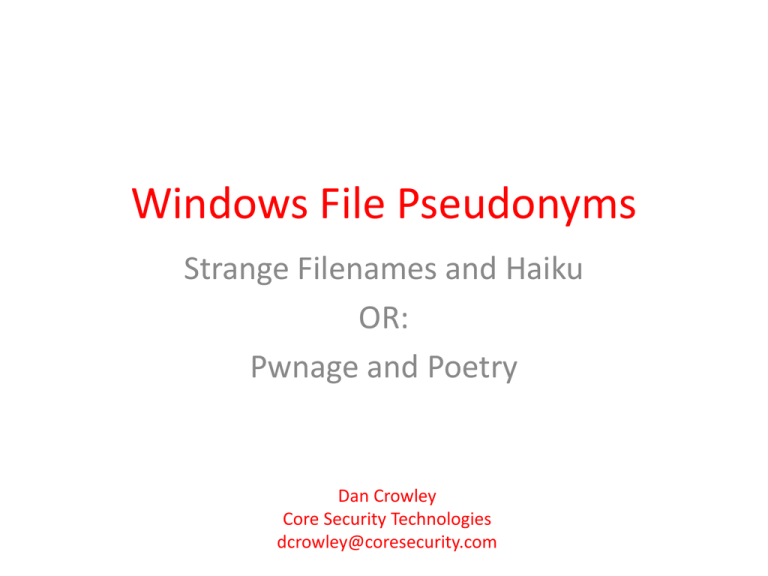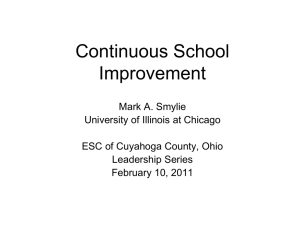Windows File Pseudonyms
advertisement

Windows File Pseudonyms
Strange Filenames and Haiku
OR:
Pwnage and Poetry
Dan Crowley
Core Security Technologies
dcrowley@coresecurity.com
A quick disclaimer
Most of the techniques presented here are
demonstrated on web-based technologies.
HOWEVER, the techniques and principles
explained should apply to any application which
takes a file path or name of any sort from user
input which will be used on a Windows system.
(Furthermore, I will provide a bottle of
delicious beer to anyone who finds a use for these
techniques which isn’t in this presentation!)
Each slide of this talk ~ Shall hence be accompanied ~ By clever haiku
The Big Problem ™
• Applications tend to do string-based analysis of file paths
– Often, to decide how to handle files
– Or whether or not files should be served
– Or whether the file path may be malicious in nature
• We can reference one file or directory with many different
equivalent strings
• Applications may not expect some of these strings
– The OS interacts with the filesystem, not the app
– Developers may not even be aware that their application will
accept such names!
• Some of these names are based on undocumented
features
One cannot expect ~ To judge books by their covers ~ And find success
8 dot 3 format
It’s self explanatory
…only to a point
8.3 ALIASES
8.3 Aliases
•
In DOS, file names must conform to the 8.3 format, meaning:
–
–
–
•
Windows likes backwards compatibility
–
–
•
A basename of (max) 8 characters
Followed by one period
Followed by a (max) three character extension
Each file (and directory!) created on default Windows installations has a DOS-compatible name
If the name isn’t 8.3 compatible, a second name (an 8.3 alias or short file name [SFN]) is made
Simplified, they are generated as follows:
–
–
–
–
–
–
Remove some characters (0x80-0xff) and convert some characters to underscores (like + and space)
Start with the first six characters
Add a tilde
And a digit to distinguish from other files starting with the same characters
Add a period
And up to the first three characters of the file extension
Windows might as well ~ Be backwards-compatible ~ With the abacus
Why do I (audience) care?
• Because “highlight.php” != “HIGHLI~1.PHP”
– If your IDS is looking for the old PHPBB highlight
command exec flaw, it may not find it
• Because “.htpasswd” != “HTPASS~1”
– Your forbidden files may no longer be forbidden
• File type may be determined by user input
– Whatever follows the last dot is the file extension
– So perhaps you can upload file.phPWNED
• And request FILE~1.PHP
• Use removed characters to force an extension <3 chars
And you will know me ~ By the trail of characters ~ After the last dot
Web App Authentication Bypass
• Consider the following scenario:
– Admin.php checks for authentication
– If authenticated, several external scripts can be called
through Admin.php at the whim of the user
• DeleteUser.php, AddUser.php, UpdateWebPage.php
– These external scripts cannot be called directly
• if($_SERVER[‘PHP_SELF’] == ‘/admin/DeleteUser.php’){
die(‘O RLY?’);
}else{ do_something_privileged(); }
• YA RLY
– ‘/admin/DeleteUser.php’ != ‘/admin/DELETE~1.PHP’
I’m taking a break ~ From sensible haiku now ~ Tonsillectomy
But wait, there’s more!
Long file names
• Maximum length: 255
• Approx. char set size: 63000
• Approx. possible names:
63000^255 = 6.78E+1223
Short file names (8.3 aliases)
• Maximum length: 12
(-1 for dot)
• Approx. char set size: 59
• Approx. possible names:
59^11 = 3.01E+18
If every file on a Windows box has an 8.3 compatible name (and by
default, this is the case) we can immensely reduce the time and resources
needed to guess filenames when trying to enumerate file names by bruteforce. This can be further reduced if the file extension is known, reducing the
complexity to 59^8 = 1.46E+14, or approx. 146,000,000,000,000 possibilities!
Huge complexities ~ Collapsing conveniently ~ To simplicity
“Let’s get rid of stuff
At the end of filenames!”
Must have once been said.
DISCARDED TRAILING CHARACTERS
Discarded trailing characters
• Certain characters at the end of file names/paths are silently
discarded by Windows!
• In Windows API calls, the following items are discarded:
– Periods
– Spaces
• The Windows shell will also allow, in specific configurations:
–
–
–
–
Double quotes (as long as they are closed properly)
Angle brackets (only in certain configurations)
Extraneous current directory markers (“/.”)
Extraneous parent directory markers with arbitrary items (fake or real)
Trailing characters ~ Of certain varieties: ~ Removed, silently.
Equivalent file path examples
• All of the following paths are valid and equivalent
when given to the Windows shell:
–
–
–
–
–
–
–
file.txt
file.txt.....
file.txt<spaces>
file.txt””””
file.txt<<<>><><
file.txt/././././.
nonexistant/../file.txt
• Different technique, similar use
– “highlight.php” != “highlight.php.”
– “restricted.txt” != “restricted.txt<space>”
Flexibility ~ In Windows nomenclature ~ Borders on silly
Ancient dinosaurs
Used to redirect data
With some devices
DOS SPECIAL DEVICE FILES
DOS special device files
• Similar to device files on *nix
• Allows file operations to be performed on
devices
• Examples include:
– CON, the console
– PRN, a parallel printer
– COM1, the first serial port
– NUL, a bit bucket (/dev/null equivalent)
• Pretty well known already, BUT…
When you speak to me ~ I redirect all of it ~ To slash-dev-slash-null.
DOS special files quirk #1
• They exist “everywhere”
• Can be accessed from any path, even:
– In directories which you are denied access to
– With an existing file as a “directory” which “contains” the
file
• Examples of equivalent paths to CON:
–
–
–
–
–
–
CON
C:CON
C:\CON
C:\..\..\..\..\..\CON
C:\restricted_dir\CON
C:\existing_file.txt\CON
Like apparitions ~ They exist in every place ~ And yet in no place
DOS special files quirk #2
• They can have any file extension, it’s ignored
• The following examples are equivalent:
– CON
– CON.bat
– CON.php
– CON.conf
– CON.thisisalongandarbitraryfileextension
– CON.<1000x”A”>
Mr. Shakespeare knows ~ A rose by another name ~ Still smells just as sweet
Denial-of-Service
• A theoretical application accepts file names and
reads the associated files
• This application blocks any file named “CON”,
“AUX”, “PRN” etc. to prevent DoS
– Applications will generally pause to read from a file
until EOF
– EOF may never arrive from devices like AUX
• It does NOT block files named, for instance,
“AUX.txt”
– Which we know is equivalent to AUX
…And while we’re at it, ~ Since we’re speaking of Shakespeare… ~ All’s well that ends well!
Buffer overflow
• A Windows application takes in a file name
• The file is verified as existing
• If it exists, the program does something with the
file name
– And might trust that it doesn’t exceed NTFS
limitations
• What if the file name is “CON.<‘A’x1000>”?
– Technically, it exists…
– …but not in the filesystem, so it’s not bound to NTFS
limitations
Why one needs all this ~ DOS file extension stuff ~ Is just beyond me
You should know better!
Microsoft Windows ~ Hoist upon its own petard ~ You should know better!
Defeating Windows file permissions
• Normal users have access to CON
• But not C:\denied_dir\denied_file.txt
• C:\denied_dir\non_existent_file.txt\CON
– No access
• C:\denied_dir\denied_file.txt\CON
– Access to console
• Now you can check the existence of files
which you cannot read in directories you
cannot read!
It is easiest ~ To acquire forgiveness ~ And not permission
Enumeration
Filenames found through brute force
Despite permissions
TOOL:
SFNBRUTE.PY
Controlling file handling
• Don’t forget:
– You can use ANY extension!
– Files are often handled based on extension
• DOS special files, then, can often be handled
as ANYTHING YOU CHOOSE!
• http://www.example.com/com1.php
– What if COM1 was attached to a serial modem?
– …Or more likely, a Bluetooth dongle?
A riddle for you… ~ When is a CON not a CON? ~ When it’s a dot-jar!
What an awful mess!
I can’t write haiku about
Namespace prefixes...
NAMESPACE PREFIXES
Namespace prefixes
• Used when files can’t be referred to with
normal paths
– Because they’re really devices
– Because they don’t exist on the local filesystem
– Because they have strange names
A distant echo ~ Of a victim, falling dead ~ The hunter shouts “PWNED!”
Minimal parsing prefix
• An invalid name or path can sometimes be
used anyway
– MAX_PATH can be exceeded
– Some restricted characters can be used
– Reserved basenames can be used
• Just precede it with \\?\
– Must be an absolute path
• No current directory indicator ( ./ )
• No parent directory indicator ( ../ )
You don’t like the rules? ~ Double wack, question mark, wack. ~ You’re welcome, buddy.
UNC (Short and Long)
• Used to refer to files on SMB shares
– Can be used to refer to files across the Internet
• \\server_name_or_ip\share\file
– This is “Short UNC”
– Nothing terribly special
• \\?\UNC\server_name_or_ip\share\file
– This is “Long UNC”
– Allows for the use of the \\?\ prefix with UNC
paths
What’s the best thing ~ About SMB traffic? ~ Credential replay!
NT device namespace prefix
• Used to refer to device namespace
• These paths start with \\.\
• Examples include:
– \\.\airpcap00\
• An AirPcap card
– \\.\GLOBALROOT\Device\HarddiskVolume1\
• The first hard disk volume on the machine
• Might be equivalent to, for instance, C:\
• Doesn’t need an assigned drive letter!
– \\.\CdRom0\
• The first disc drive on the computer
• WinObj from Sysinternals will allow you to browse the NT
device namespace
The device namespace ~ Allows access to devices ~ Using file paths
NTLM credential capture
• When accessing SMB shares, authentication
may be requested
– If an attacker runs the SMB server, you can bet it
will
• The SMB client machine will often send stored
credentials automatically
– And as you may know these credentials can be
replayed or cracked
– And we can trigger a machine to access an SMB
share with a UNC path!
A replay attack ~ With SMB credentials ~ Should not still succeed!
Directory traversal
• “C:\” doesn’t match:
– \\?\C:\
– \\127.0.0.1\C$\
– \\127.3.13.37\C$\
– \\?\UNC\127.0.0.1\C$\
– \\.\GLOBALROOT\Device\HarddiskVolume1\
• …but they’re all equivalent!
I ought to mention ~ Directory traversal ~ Ed Skoudis said so!
Buffer overflow
• Minimal parsing prefix allows for the use of
paths exceeding MAX_PATH
– Some developers don’t know you can exceed
MAX_PATH
– …or assume that if the file exists that it can’t
exceed MAX_PATH
NOP NOP NOP NOP NOP ~ NOP NOP NOP NOP NOP Shellcode ~ Pointer to NOP sled
Making Windows rootkits deadlier
• Imagine that you’re a Windows sysadmin
• Someone creates a file named “CON” with the
minimal parsing prefix
• You try “type CON” at the command line
–
–
–
–
–
Your command prompt “hangs”
None of your programs open it properly
Windows Explorer can’t delete it
You cry
You pretend it doesn’t exist
• or convince yourself it really should be there
My reaction to ~ “Undocumented feature” ~ Is unbridled rage.
Defeat AV systems
1. Make files with illegal names
(“con.exe”, “lol.exe.”, etc.)
2. Put something malicious in them
3. Execute them
4. ???
5. PROFIT!!!
An AV system ~ Should reliably open ~ All suspect files
Client-side Attacks
• Switching security zones
– Reference “C:\file.txt”
• NO THAT’S A LOCAL FILE BAD HACKER
– Reference \\127.0.0.1\C$\file.txt
• A UNC path! I know these, they’re Intranet stuff. No
prob, Bob.
• Check out “Internet Explorer turns your personal computer
into a public file server”
– Jorge Luis Alvarez Medina, BH DC 2010
How do I pwn thee? ~ Let me count the ways; No, wait: ~ Just one is enough!
Now I understand,
But I still don’t believe you.
SHOW ME THE MONEY!
DEMONSTRATION:
NGINX AND PHP ON WINDOWS
Questions?
There’s no dumb question…
“Is the computer plugged in?”
Is pretty bad, though.
Dan Crowley
Core Security Technologies
dcrowley@coresecurity.com






